Abstract
Soft rocks in various forms of marly materials have an important role in the geological structure of Dalmatia (Croatia) and Budapest region (Hungary). These materials can cause serious problems in design and construction, due to their complex behavior under atmospheric conditions. For the purpose of better understanding soft rocks behavior and their properties, a database with approximately 600 samples collected throughout Dalmatia was made and collated along with 260 samples from the Budapest area. Based on the collected data, 30 regression analyses were performed among 14 material properties, and eight different types of linear and non-linear correlations with high coefficients of determination were selected, which connect the important mechanical properties (uniaxial compressive strength and Young’s modulus) with physical properties of marls (porosity, dry unit weight, and ultrasonic pulse wave velocity). Most of the determined relations show symmetry between the marls from the Dalmatian region and the Budapest region, and the relation between dry unit weight and uniaxial compressive strength asymmetry can be observed between the marls with different origins. Obtained correlations may be used in cases where little or no information on geotechnical parameters is available, or where results need to be verified due to the problems present in soft rock testing.
1. Introduction
The coastal region of Croatia (Dalmatia) lies on the Eocene flysch formations. The most common lithotypes of the flysch formations found in Dalmatia are breccias, breccia-conglomerates, sandstones, detrital limestones, and marls, with varying amounts of CaCO3 components [1]. There is a symmetry between the two investigated areas, as both the Split area in Croatia and the Budapest area in Hungary abound with marly material that varies from clayey marls to calcareous marls. Marl is a rock which contains clastic material of the clay dimension (<0.002 mm) and carbonate (calcite); therefore, it is defined as transitional rock material between clastic and chemical sedimentary rocks [2].
Based on their physical and mechanical properties, these materials are considered soft rock. This paper attempts to outline or dispute this hypothesis using an extensive dataset of previous analyses. Due to their complex structure and poor cohesive bonds between the solid particles, these materials are subject to deterioration and degradation under atmospheric agents, which may be referred to as weathering. Problems regarding sampling and site investigation are due to degradation and crumbling, difficulties in the geomechanical classification under traditional systems, poor strength, fast weathering, and many other characteristics make soft rocks challenging materials to utilize in testing and construction [3].
Considering previous difficulties experiencing during testing, and for the purposes of better understanding soft rock behavior and its properties, a database containing around 1500 samples, collected during site investigations throughout Dalmatia between 1998 and 2016, was created and collated along with around 260 core marl samples from the Budapest area (Figure 1). The samples from the Dalmatia region consist of a wide range of sedimentary rocks: limestone, marl, dolomite, breccia, conglomerate, sandstone, siltstone, calcareous sinter, and tuff. In this study, an emphasis is placed on the behavior and properties of marls. Therefore, the collected data were divided based on material type, and the data referring to marly materials were extracted and then analyzed (603 samples from the Dalmatia region).
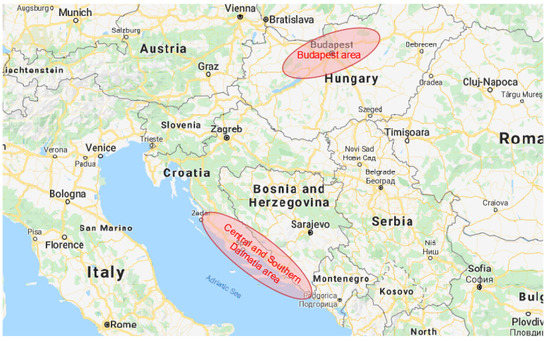
Figure 1.
Location of sampling areas: Budapest area and Dalmatia area.
Based on the collected data, correlations between geotechnical intact rock parameters (especially mechanical properties of strength and deformability—uniaxial compressive strength UCS and static Young’s modulus Es) and physical properties (porosity n, dry unit weight γd, and ultrasonic longitudinal pulse wave velocity vp), were obtained using statistical methods of regression. These correlations provide assessment tools for researchers and professionals in geotechnical engineering, where little or no geotechnical data are available. They can also be used to check test results which are often difficult to obtain or are insufficient, since soft rocks are difficult to test. Naturally, for some parameters, it will be possible to find more empirical relations and diagrams in the literature. It is always necessary to make a critical judgment about applicability in a particular case and report the source used according to the principles of good practice.
Such an approach, using the correlations of rock properties, was applied and described by Šestanović [1,2], Kanji [3], Kanji and Galvan [4], Faim, Andrade and Figueiredo [5], Sharma and Singh [6], Vasanelli et al. [7], and Ameratunga, Sivakugan and Das [8], which are discussed more in Section 4. Alongside authors dealing with engineering rock mechanics, Hudson and Harrison [9] also describe the determination of rock mass properties (e.g., overall modulus of deformation; modulus of deformation of a rock mass) and rock failure criteria (and hence, also the tensile strength, cohesion, and friction angle) using intact specimen properties (UCS, Es) together with discontinuity parameters. These approaches emphasize the importance of the input intact rock parameters, especially the UCS, as probably the most widely used design parameter.
The main aim of this work is to present the correlations obtained for geotechnical parameters based on the collected data on marly soft rocks from the regions of Dalmatia (Croatia) and Budapest (Hungary). Since soft rocks are highly specific and demanding materials, it is difficult to obtain geotechnical data in some cases. Typical values of the mentioned geotechnical intact rock properties and their interrelationships are therefore addressed.
2. Materials and Methods
The samples were mainly collected during site investigation and analyzed for the purpose of geotechnical design. Consequently, analyzed properties depended on the type of the planned construction works and structures, and not all samples had the same properties tested. Most of the tested parameters were determined by the authors, under the controlled conditions of accredited laboratories and according to the suggested testing methods and standards (BS 1377-2 [10], ASTM D4373 [11], SM ISRM [12], ASTM D7012 [13]). A smaller proportion of the properties were determined in different laboratories, and possibly under different laboratory conditions and methods, which may affect the uniformity of obtaining procedures and the availability of some tested parameters.
Given the fact that the obtained correlations include a large number of samples and related test results of various properties (a total of about 860 samples; 600 for the area of Dalmatia and 260 for Budapest area), and that in the literature it is difficult to find more specific results for marls (due to all known problems with sampling, sample preparing and testing—like disintegration, crumbling, fast weathering), it may be predicted that the obtained results would gain traction with time and further geotechnical engineering applications, and in the scientific community. As with other correlations, when using the results, it is necessary to assess their applicability by comparing the properties of specific marls and those tested here, as well as to indicate the source.
2.1. Properties of Marls from the Dalmatian Area
The studied Dalmatian marls were formed during the Eocene period. These marly formations form a part of alternating layers of flysch deposits. Flysch was generated in moderate to deep marine settings and is represented by alternating layers of carbonates (limestone, calcarenite, etc.) and clayey sediments, such as marls (Figure 2). Marls from the Dalmatian area are usually of a bright yellow, gray, brown, or bluish color (Figure 3a) and contain between 15% and 85% of clay, and between 15% and 85% of carbonate (CaCO3) [14].
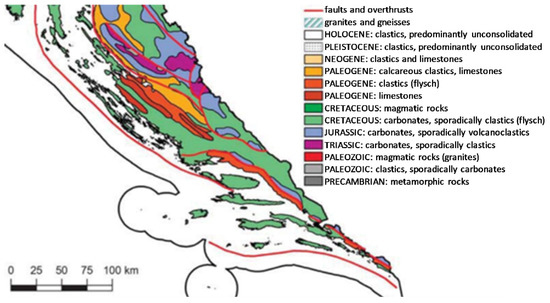
Figure 2.
Geological map with the occurrence of Dalmatian marl with orange color (modified after Mostečak et al. [16]).
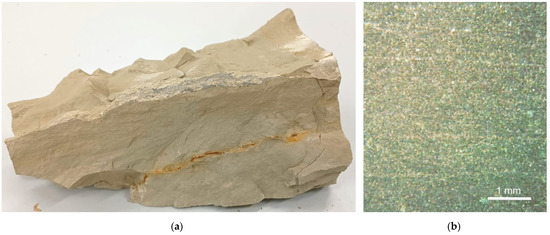
Figure 3.
Characteristic features of marls from the Dalmatian area. (a) The bright yellow Dalmatian marl; (b) microscopic image of Dalmatian marl (crossed polars), from Aljinović [17].
The microfacies of the Dalmatian marl reflect its depositional environment. It is a slightly laminated wackestone. The main compounds are tiny calcispheres with sizes in the order of 10 micro-meters. The groundmass is dominated by calcitic micrite, and shows some lamination. Other than calcite, small amounts of clay minerals are also observed. The proportion of clay minerals can increase, and the micro-fabric becomes clay-dominated (Figure 3b). Mineralogical content of these marls mostly consists of calcite, dolomite, quartz, plagioclase, chlorite, smectite, vermiculite, and micaceous minerals in different ratios [15]. The term “micaceous minerals” refers to a mixture of clay minerals: illite, smectite, and possibly muscovite. Based on the content of the calcite components, marls were divided into several groups; shown in Table 1. According to the composition of these marly materials, they show symmetry when the clay and calcite content are approximately the same; in this case, they are called marls. When these materials have asymmetric composition, they are considered clayey marls or calcareous marls. Their properties mostly depend on their composition.

Table 1.
Classification of carbonate rocks considering the content of the calcite component (from Šestanović [2]).
In this research, emphasis is placed on the analysis of samples defined as marls, weathered marls, clayey marls, and marly clays (603 samples from the database). Main properties of these materials are shown in Table 2.

Table 2.
Properties of the marly materials from the Dalmatian area in the database.
Around 25% of marl samples, with known uniaxial compressive strength (UCS), have a UCS value above the upper limit of what is considered to be a soft rock, which is around 25 MPa. These are mostly samples with higher calcite content, and can be described as calcareous marls.
According to the engineering classification of intact rock [18,19], shown in Figure 4, Dalmatian area marls can be classified as low toughness and ductile rocks with low to medium strength, due to low to medium Es and UCS ratios. These types of rock show great instability when exposed to atmospheric agents (degradation and crumbling).

Figure 4.
Engineering classification of intact rock with results obtained for tested marls from the Dalmatian area [18,19].
Weathered marls, clayey marls, and marly clays, for which Atterberg limits were tested, can be observed through a Casagrande-Mitchell plasticity diagram [20]. Using this diagram, clay components in marl can be determined based on plasticity index (Ip) and liquid limit (wL) values. Clay component minerals react with water, which leads to swelling and breaking of the cohesive bonds between the solid particles by weathering. As is shown in Figure 5, Dalmatian area marls dominantly contain illite minerals, which are not overly prone to swelling.
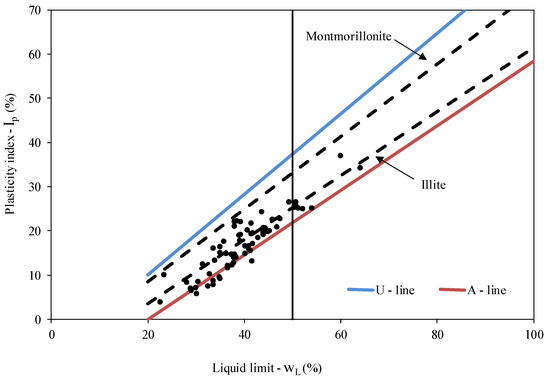
Figure 5.
Casagrande-Mitchell plasticity diagram [20] showing the data obtained from testing of marls from the Dalmatian area.
2.2. Properties of Hungarian Marls
In the Budapest region, there are two formations that are considered marls according to their calcium-carbonate content: the Eocene Buda Marl Formation and the Oligocene Kiscell Clay Formation. The calcium-carbonate content of the Buda Marl varies from 30% to 70%, while the mean carbonate content of the Kiscell Clay is approximately 15% [21,22]. The Eocene marl, which is similar in age to Dalmatian marl, is a wackestone, according to micro-facies analyses, but there are carbonate-rich layers that are considered calcareous marl, with a higher amount of carbonate particles and bioclasts, and characterized as packstones. The Kiscell clay has a low carbonate content, and it is often bioturbated, representing a deep-water marine deposit.
Both formations were exposed during construction activities in the Budapest region. Kiscell Clay is the host rock of the Metro line 4 [23,24], while the Buda Marl is the host rock of several underground construction projects, such as the Castle garage and the Castle Bazaar [25].
These two rock formations are not uniform. The upper layers are weathered and the beds behave like clayey material. In the cover zone of the rock beds, carbonate is leached and pyrite and other iron-containing minerals are oxidized to limonite. It causes a color change, so the gray color turns to yellow or brown. The difference between the yellow weathered and gray freshly exposed marl is visualized in Figure 6a. In the weathered zone, a jointed layer can be found and, finally, the intact part of the strata. These lower layers are always gray in color.
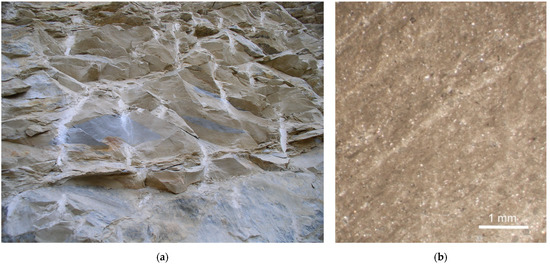
Figure 6.
Characteristic features of Buda marl. (a) Upper weathered yellow beds and grey non-weathered parts of Eocene Buda marl; (b) thin-section photograph of Buda marl shows the laminated structure of the marl, which is a characteristic feature (crossed polars).
Buda marl is primarily composed of a micritic calcite matrix with a small percentage of clay content. A typical feature is an abundance of small bioclasts, such as tiny shell fragments, bryozoans, and predominant calcispheres. The micro-fabric is often laminated. Its microfacies are wackestone, rarely floatstone, when abundant shell fragments prevail (Figure 6b). Small flakes of clay minerals and a minor amount of limonite are also visible in thin sections. Traces of bioturbation are also visible. Compared to Dalmatian marl, it usually has a higher carbonate content and is more cemented. The Buda Marl Formation forms a part of the Hungarian Eocene system (Figure 7).
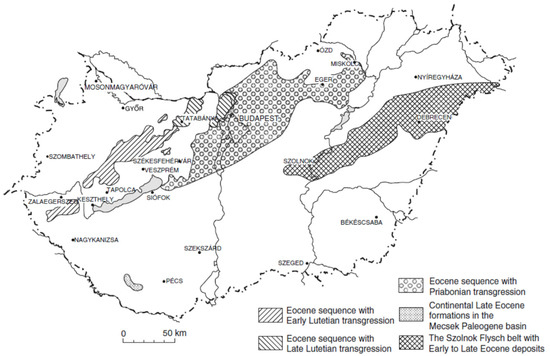
Figure 7.
Distribution of the Eocene depositional systems in Hungary. Buda marl is found within the Priabonian transgression system, marked by circled pattern as ‘Eocene sequence with Priabonian transgression’ (modified after Haas [26]).
The core samples from Budapest contain mostly calcareous marls, marls, and clayey marls. The main properties of the dataset from the Budapest area are given in Table 3.

Table 3.
Properties of the Buda marl.
The tested Buda marl is a low to moderate strength rock. It has around two times higher average uniaxial compressive strength than the Dalmatian marls, but the average Young’s modulus is almost the same in both cases.
2.3. Analytical Methods
Since the database covers a wide range of sedimentary rock types, the collected data were first divided based on the material type. The data referring to marly materials were extracted and then analyzed.
As mentioned, the data were not collected systematically and not all samples had the same parameters tested. Consequently, the amount of data in different analysis varies. The most common parameters in the database are: calcium carbonate content (CaCO3), uniaxial compressive strength (UCS), dry unit weight (γd), water content (w0), static Young‘s modulus (Es), and point load strength (Is(50)). The value of porosity (n) was derived from the known density values.
After data sorting, regression and correlation analysis were conducted in order to obtain correlations between the properties, starting with correlations already obtained by different authors, as described in the discussion chapter. The analysis was performed in statistical analysis software NCSS 2019 [27], using linear and non-linear simple regression analysis options.
The starting point in the regression and correlation analysis is the definition of the scatter plot and the calculation of the coefficient of determination (R2). The shape of the scatter indicates the existence of a correlation between the variables and the type of correlation (linear or non-linear), whereas the correlation coefficient value R indicates the strength of the correlation. Values above 0.40 indicate significant correlation, and values above 0.70 indicate strong correlation between the variables.
The regression model is an analytical expression of the correlation between two or more variables, and it is a result of regression analysis. In this research, two regression models were analyzed:
- simple linear regression model
- simple non-linear regression model
- y = dependent variable;
- x = independent variable;
- B0, B1 = regression coefficients resulting from the least square method;
- ε = error.
3. Results
For this research, 30 regression analyses (linear and non-linear) were performed between 14 different material properties. The starting point of the regression analysis were correlations between the properties previously obtained by different authors, as described in Section 4. The best-fit correlations for the analyzed data, with moderate and high coefficient of determination values, are shown in Table 4.

Table 4.
Overview of the obtained correlations.
Hereafter, a graphical representation of the obtained correlations for one or the both data sets is given and collated with relationships obtained for the pooled data (if possible/applicable).
The porosity (n) and ultrasonic pulse wave velocity (vp) of the Dalmatian area marls show very high correlation with the coefficient of determination, R2 = 0.81 (Figure 8). Better correlation could be obtained by increasing the number of data; i.e., increasing the application of ultrasonic pulse wave velocity tests in practice. For the Buda marl, the correlation between dry density and ultrasonic pulse wave velocity results in almost the same R2 value as the previously described porosity—US wave relation for the power function. The value of the coefficient of determination is R2 = 0.74, but for linear regression the R2 value is smaller: R2 = 0.61 (Figure 9).
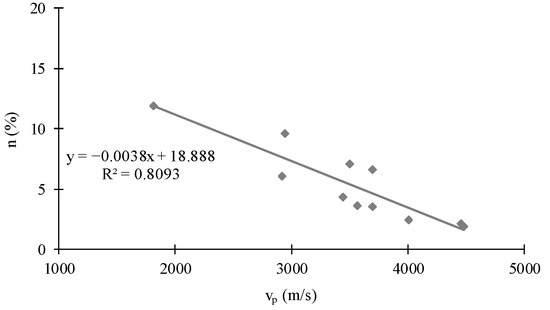
Figure 8.
Porosity and ultrasonic pulse wave velocity relationship (Dalmatian area marls).
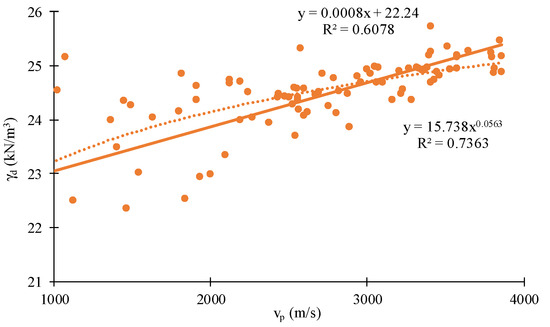
Figure 9.
Density and ultrasonic pulse wave velocity relationship (Buda marl).
Uniaxial compressive strength (UCS) and ultrasonic pulse wave velocity (vp) showed significant correlation in both cases. The coefficient of determination for linear regression is almost the same for both—R2 = 0.52 for the Dalmatian area marl and R2 = 0.51 for the Buda marl (Figure 10a), but the slopes of the lines are very different. The presence of a few outliers is noted on the scatter plots in Figure 10.
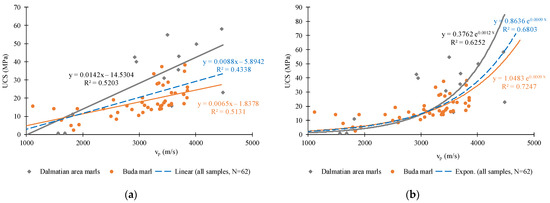
Figure 10.
Uniaxial compressive strength and ultrasonic pulse wave velocity relationship of studied marls. (a) Linear regression; (b) non-linear regression.
By omitting outliers, a better correlation is obtained. In this case, dropping outliers is not reasonable. Therefore, the obtained correlation is kept as it is. For both data sets, a non-linear regression was checked as well. The correlation with exponential equation shows better coefficients of determination, R2 = 0.63 (Dalmatian area marls) and R2 = 0.72 (Buda marl), compared to the linear one (Figure 10b). The same is true if pooled data are observed, where R2 is significantly better for non-linear regression (R2 = 0.68).
Static Young‘s modulus (Es) and ultrasonic pulse wave velocity (vp) show very high correlation in the case of the Dalmatian marls, with R2 = 0.84 (Figure 11a). However, for the Buda marl, the linear regression did not provide a good relationship between the two parameters (R2 = 0.32). Therefore, the data were also analyzed by non-linear regression. An exponential equation was used to describe the correlation between the ultrasonic pulse wave velocity and static Young‘s modulus for the Buda marl, and the R2 value of 0.68 was obtained, which is considerably higher than the previous result for the linear correlation. For marls from the area of Dalmatia, non-linear regression does not give a better correlation than linear regression, but for all analyzed samples from the both data sets using the exponential relationship, the R2 value of 0.68 is obtained, the same as for Buda marl (Figure 11b).
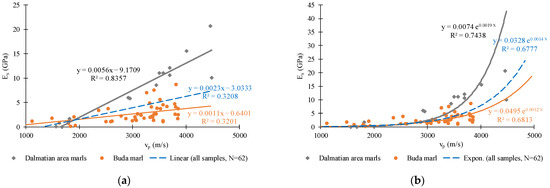
Figure 11.
Static Young’s modulus and ultrasonic pulse wave velocity relationship of marls. (a) Linear regression; (b) non-linear regression.
For the correlation of uniaxial compressive strength (UCS) and static Young‘s modulus (Es), transformation of UCS as a dependent variable was used in order to fulfill the normality condition of the statistical analysis. Therefore, the square root of UCS was used as a dependent variable. Transformed √UCS and Es show significant correlation with the coefficient of determination R2 = 0.60 for the linear correlation for the Dalmatian area marls, as well as the analysis of both data sets (R2 = 0.61; Figure 12a). The analysis of the data set of the Buda marl resulted in a higher R2 for the linear regression (R2 = 0.75).
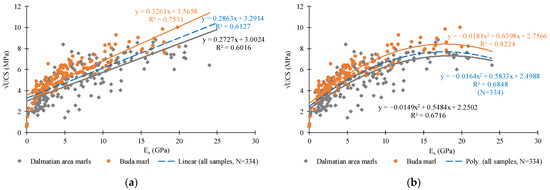
Figure 12.
Uniaxial compressive strength and static Young’s modulus relationship of marls. (a) Linear regression; (b) non-linear regression.
The shape of the scatter also indicates the possibility of non-linear parabolic correlation, with R2 = 0.67 for the Dalmatian area marls and R2 = 0.82 for the Buda marl (Figure 12b). The data on the scatter plot are quite dissipated and the given equation does not fit the data well enough, and therefore, it should be considered with caution. However, the value of the coefficient of determination and the fact that the higher values of strength imply higher values of modulus, confirm the validity of the presumption that these variables are truly correlated. This relation shows symmetry between the Dalmatian area marls and the Buda marls. The two scatter plots and the shape of the correlation lines are similar. The difference is that the marls from the Dalmatian region have more UCS results with lower strength; therefore, the correlation curve is below the one related to the Buda marls.
For the static Young’s (Es) and dynamic (Edyn) modulus of elasticity relationship, which were analyzed for the Dalmatian area marls, it was also necessary to transform the dependent variable to fulfill the normality condition of the statistical analysis, and the square root value of the static modulus (Es) was used as a dependent variable. Transformed √Es and Edyn, calculated from the value of ultrasonic pulse wave velocity, show significant correlation for linear relationship (R2 = 0.52) and high correlation for non-linear relationship, with the coefficient of determination R2 = 0.62 or 0.94, depending on whether clayey marls were omitted from the analysis or included (Figure 13).
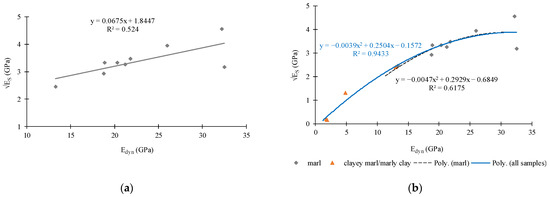
Figure 13.
Static Young’s and dynamic modulus of elasticity relationship for the marls of the Dalmatian area. (a) Linear regression; (b) non-linear regression.
This correlation, as well as other obtained correlations with ultrasonic pulse wave velocity, shows the importance of implementing this test method to standard use in sample testing. The advantage of this method is the fact that it is non-destructive, which is important when dealing with sensitive materials prone to weathering, such as soft rocks.
The uniaxial compressive strength (UCS) and dry unit weight (γd) relationship, as well as that for UCS and porosity (n), show non-linear behavior. Therefore, these relationships are described using simple non-linear regression as an exponential function. For the Buda marl only, the uniaxial compressive strength and dry unit weight relationship were analyzed.
Both relationships show high correlations, with the R2 value of 0.79, for the Dalmatian area marls (Figure 14 and Figure 15). For the Buda marl, low R2 value is an effect of the lack of lower range density and strength values. However, the Buda marl values perfectly complement the Dalmatian marl values. This relation shows asymmetry between the two types of marls. For the Buda marls, the correlation is appreciable only in the case of the pooled results with the Dalmatian area marls.
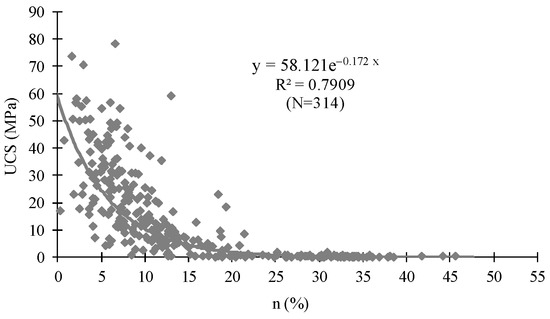
Figure 14.
Uniaxial compressive strength and porosity relationship for the marls of the Dalmatian area.
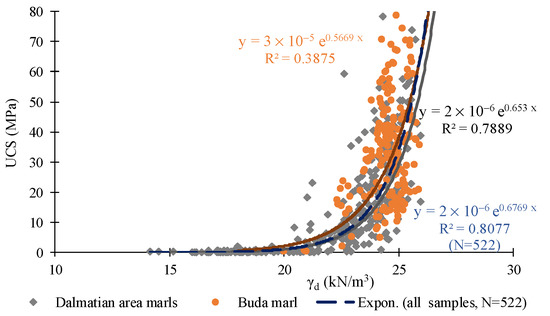
Figure 15.
Uniaxial compressive strength and dry unit weight relationship of marls.
4. Discussion
In the current study, Croatian and Hungarian marls have geological similarities. In both countries, the marls were formed during the Eocene period. The Dalmatian marl is a deeper water sediment with a typical flysch structure. In contrast, the Hungarian marl is considered a moderately deep water deposit of a carbonate ramp. Despite these depositional differences, there are many similarities in appearance and mineralogical composition between Croatian and Hungarian Eocene marls. The complex behavior of soft rocks and problems related to their classification, sampling, and testing, lead to the need for better understanding of the soft rock properties and finding adequate solutions for the related problems. Accordingly, many authors have previously dealt with soft rock problems, such as Živec et al. [28], Gao et al. [29], and Auflič et al. [30], and the correlations between their properties [8,31].
Kanji and Galvan [4] collected and analyzed data from more than 200 publications concerning soft rock behavior. Based on that data, they considered relationships between porosity and absorption, porosity and density, porosity and UCS, density and UCS, and “modulus of deformability” and UCS. The obtained relationships showed that absorption, porosity, and density were very well correlated. The correlation between the UCS and porosity shows that the lower the porosity, the higher the strength of the material, which allows predictions of the UCS value based on the porosity. The modulus of deformability and UCS relationship shows that higher material strength indicates higher values of modulus.
Regarding the correlations between the UCS and density or porosity, the results obtained in this study have been compared with some recently published reports and graphs revealing literature results which include multiple types of soft rocks [31]. Thus, for example, the results in Figure 14 and Figure 15 are shown together with the “overall” soft rocks results for dry and saturated samples (Figure 16 and Figure 17).
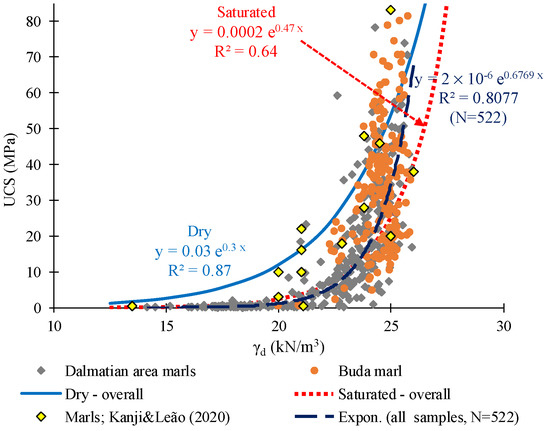
Figure 16.
Uniaxial compressive strength and dry unit weight relationship of marls—a comparison of the results obtained here for the both data sets (marls from the area of Dalmatia and the Buda marl) and the “overall” soft rocks results of the study by Kanji and Leão [31].
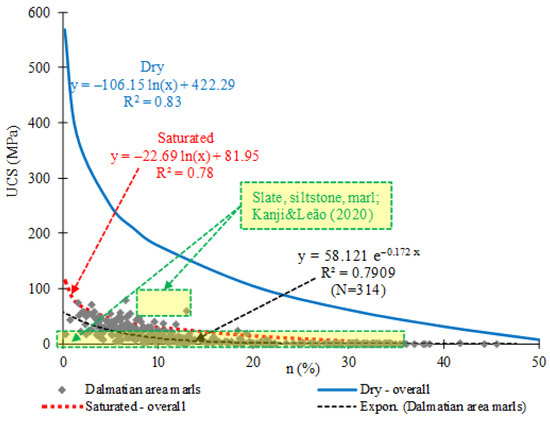
Figure 17.
Uniaxial compressive strength and porosity relationship of marls—a comparison of the results obtained here for marls from the area of Dalmatia and the “overall” soft rocks results of the study by Kanji and Leão [31].
According to the comparison of the results in Figure 16 and Figure 17, the results obtained here fit well into the overall results from [31]. The difference is that the marl results from this research were obtained for samples with natural water content (w0 from Table 2), while the results reported from Kanji and Leão [31] were presented for two extremes—dry (solid line) and saturated samples (dotted line). Additionally, the number of reported results for marls in the latter study are very few (14 in Figure 16 and only 4 in Figure 17), while in this study the number of marl samples is significant (300–500), which contributes to reliability and applicability (especially if the difficulties in preparing samples and conducting tests on marls is considered).
It is interesting to note (Figure 16) that the onset of steep growth of the UCS-γd curves corresponds to the upper limit of UCS for soft rocks of around 25 MPa. The results in Figure 17 show that marls, like some siltstones and shales, have lower strength regardless of porosity.
For the Young’s modulus Es, it can be concluded that in both cases (soft rocks in general [31] and marls from this study; Figure 4) the results of Es/UCS ratio enter in the range of medium/average (M; 200:1—500:1) and low (L; <200:1) modulus ratio. Furthermore, for soft rocks in general [31], the ratio Edyn/Es ranges from 1.5 to 2, and marls from this study show the Edyn/Es ratio of 1.6 to 2.2 (not considering clayey marl/marly clay), where the amount of results is small and needs to be improved.
Referring to the Dalmatian marls, Šestanović [1] identified the existence of a relationship between calcite content (CaCO3) and UCS, and consequently, predisposition to weathering.
Kanji [3] also indicates the possibility of applying ultrasonic pulse wave velocity test methods based on the correlation between the dynamic modulus of elasticity (Edyn) and static (Young) modulus. Faim, Andrade, and Figueiredo [5] have obtained correlations between ultrasonic pulse wave velocity (vp) and uniaxial compressive strength (UCS), as well as between vp and point load strength (Is(50)), on dolomitic limestone samples in Coimbra (Portugal). Similar to the results comparison in Figure 16 and Figure 17, and regarding the marl samples from this research, the comparisons of the obtained Es-vp and UCS-vp correlations with the “overall” soft rocks results in [31] are given in Figure 18 and Figure 19.
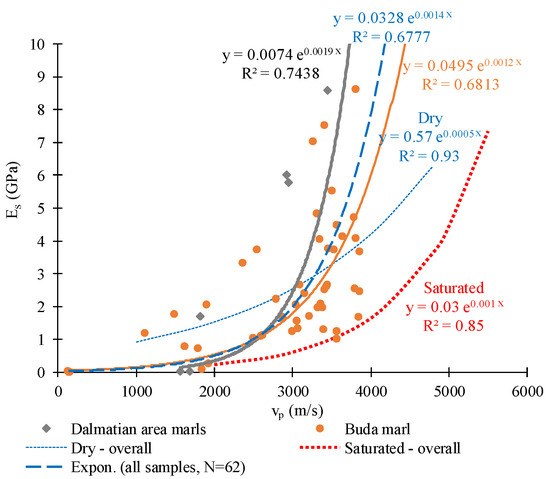
Figure 18.
Young’s modulus and ultrasonic pulse wave velocity relationship of marls—a comparison of the results obtained here and the “overall” soft rocks results of the study by Kanji and Leão [31].
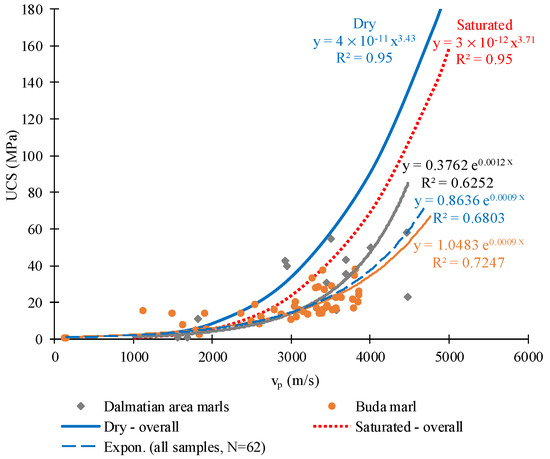
Figure 19.
Uniaxial compressive strength and ultrasonic pulse wave velocity relationship of marls—a comparison of the results obtained here and the “overall” soft rocks results of the study by Kanji and Leão [31].
The results of the Es-vp relationship between the Dalmatian area marls and Buda marls do not fit well with the overall soft rocks results of Kanji and Leão [31] for dry samples (Figure 18), but the amount of comparable results is small (marls were not included in the latter study). However, the form of non-linear regression for saturated samples in Figure 18 corresponds to the relationship obtained for the combined results of marls from the regions of Dalmatia and Budapest (all samples, N = 62). The shift of the curve to the left is due to the fact that the latter results were obtained on samples with natural water content.
The overall soft rocks results obtained by Kanji and Leão [31] for the UCS-vp relationship of dry and saturated samples are close to the results of the Dalmatian area marls and Buda marls, but the results are not entirely comparable. The study by Kanji and Leão did not include marls and there are very few results for soft rocks that could be compared to marls (e.g., siltstone, shale, and claystone).
It can generally be observed that, for the same ultrasonic longitudinal pulse wave velocity value vp, marls from this study show approximately the same (up to vp of about 3000 m/s) or higher value of the Young’s modulus and a lower UCS value (Figure 18 and Figure 19). The UCS, up to the value of the upper limit for soft rocks, which is about 25 MPa, corresponds to vp values up to approximately 3000–3500 m/s, and, above that, the more pronounced growth of Es and UCS with vp commences. UCS-vp appears to be a better correlation than Es-vp in terms of reliability and the scatter of results.
According to Sharma and Singh [6], there are a number of factors that influence the P-wave velocity in rocks, such as lithology, density, porosity, anisotropy, pore water, confining pressure, and temperature, as well as the properties of the rock as a mass. Vasanelli et al. [7] have evaluated the effect of anisotropy and water presence on the ultrasonic pulse wave velocity of a highly porous building limestone, and how the presence of those factors affects the correlations between the ultrasonic pulse wave velocity and other physical and mechanical properties of the material. Since the samples used in this research were not collected and tested for the research itself, but mostly for the purpose of geotechnical design, there is no detailed information about the homogeneity of the tested samples. Hence, future research should be focused on exploring the effect of the aforementioned sample properties on the results of ultrasonic pulse wave velocity tests, as well as on the correlations listed previously.
It should also be noted here that the tests carried out relate to the laboratory testing, and therefore, to the intact rock, which means (by definition of the intact rock) that the test specimens represent the whole drill core not affected by the gross structural discontinuities. Therefore, the samples can be considered to be as homogeneous as possible, and the results obtained should not be assigned to the whole rock mass, but the rock mass properties must in particular be determined for each project, considering both intact rock properties and discontinuity characteristics within the geological and geophysical surveys at the site.
In this regard, Ameratunga, Sivakugan, and Das [8] provide correlations to assess design parameters and describe how the addressed parameters UCS and Es, as described here, can be further used to estimate the properties of rock mass, which is the ultimate goal in geotechnical projects and activities. For example, ultimate skin friction of piles in rock and ultimate end-bearing pressure in rocks can be estimated using the UCS. Furthermore, rock mass Young’s modulus EM can be estimated via Young’s modulus of intact rock Es and UCS, using their ratio known as “modulus ratio”, which according to [8], for marls, is within the range Es/UCS = 150–200. This is consistent with the Es/UCS values shown in Figure 4 (low modulus ratio <200:1 prevails). EM also correlates with some combination of properties such as Es, UCS, RQD (Rock Quality Designation), RMR (Rock Mass Rating) classification system, or GSI (Geological Strength Index) and discontinuity characteristics (closed or open joints, discontinuity frequency), wherein RMR and GSI include the UCS [8,9]. From the above, a possible further application and the significance of the obtained correlations is recognized.
It can be seen in Figure 10, Figure 11, Figure 12 and Figure 15 that the interrelationships between the two datasets for the marls from the region of Dalmatia and the Buda marl show complementarity and approximate symmetry with respect to the correlations obtained for the pooled results.
Additional studies are needed to clearly outline the durability of these marls in terms of freeze-thaw, since these parameters are essential in the design of open cliff faces such as road or railway cuts.
5. Conclusions
Dry unit weight, porosity, ultrasonic pulse wave velocity, uniaxial compressive strength, and Young’s modulus of Croatian and Hungarian Eocene marls were statistically analyzed in the form of 30 regression analyses using 14 material properties. Depending on compared parameters, either linear or non-linear, simple regression analyses were performed. Based on the regression analysis, correlations between the properties were obtained. Most of the correlations show symmetry, but asymmetrical relationships were also found between the marls with different origins.
The analysis of the ultrasonic pulse wave velocity correlation to different material properties, such as dry density, porosity, uniaxial compressive strength, and Young’s modulus demonstrated that the ultrasonic pulse wave test is an important and useful non-destructive test method. High correlations were obtained between the ultrasonic pulse wave velocity and all the above properties, mostly non-linear, and for porosity, dry density, and Young’s modulus, also linear. These analyses resulted in symmetrical results between Dalmatian area marls and Buda marls for the uniaxial compressive strength and Young’s modulus.
The strength and deformability parameters (uniaxial compressive strength versus Young’s modulus) show a very good correlation with a high coefficient of determination in terms of linear regression analysis, whereas the application of non-linear correlation improves the value of the coefficient of determination. The uniaxial compressive strength values of the Buda marl are usually higher than the Dalmatian area marls, while there is no significant difference between the Young’s modulus values of the marls from these different regions. These relations also proved the symmetry between the marls from different locations.
Finally, the relation between the uniaxial compressive strength and dry unit weight and porosity was analyzed. The statistical analysis results for these properties were slightly different for the Dalmatian area marls and the Buda marls. However, the Buda marl data perfectly complement the Dalmatian marl dataset. The range of marls from the Dalmatian area was wider, while there were no dry unit weight values bellow 20 kN/m3 in the Buda marl. The result of this relation was asymmetrical, but the Dalmatian area marls and the Buda marls data sets were complementary; in the case of the Buda marls, the obtained correlation was applicable only when it was analyzed together with the Dalmatian area marls.
The obtained correlations may be used for the purposes of geotechnical design; for example, in cases where little or no information on geotechnical parameters is available or where results need to be verified due to the problems present in soft rock testing (disintegration and decay of specimens, crumbling, impossibility of proper sample preparation, complex behavior, and relatively fast change of properties). Applicability will depend on the properties of the analyzed materials in relation to those presented here, and in any case it should be critically evaluated for each project, as well as for all other correlations.
Author Contributions
Conceptualization, A.D., N.Š.C. and P.G.; Data curation, N.Š.C., G.V., Á.T. and P.G.; Formal analysis, A.D., N.Š.C. and P.G.; Funding acquisition, N.Š.C. and Á.T.; Investigation, A.D., N.Š.C., G.V. and Á.T.; Methodology, A.D.; Project administration, A.D. and P.G.; Resources, N.Š.C., G.V., Á.T. and P.G.; Software, A.D.; Supervision, N.Š.C., G.V., Á.T. and P.G.; Validation, A.D., N.Š.C. and G.V.; Visualization, A.D., N.Š.C. and P.G.; Writing—original draft, A.D., N.Š.C., G.V. and P.G.; Writing—review and editing, N.Š.C., Á.T. and P.G. All authors have read and agreed to the published version of the manuscript.
Funding
This work has been supported in part by the Croatian Science Foundation under the project “Experimental and numerical investigations of mechanisms in unsaturated geomaterials” (UIP-2017-05-3429). It has also been partially supported through project KK.01.1.1.02.0027, a project co-financed by the Croatian Government and the European Union through the European Regional Development Fund—the Competitiveness and Cohesion Operational Programme. The APC was funded by University of Split, Faculty of Civil Engineering, Architecture and Geodesy, Split, Croatia and Budapest University of Technology and Economics, Department of Engineering Geology and Geotechnics, Budapest, Hungary. The Hungarian part of the research is part of project no. BME-NVA-02, implemented with the support provided by the Ministry of Innovation and Technology of Hungary from the National Research, Development and Innovation Fund, financed under the TKP2021 funding scheme.
Institutional Review Board Statement
Not applicable for studies not involving humans or animals.
Informed Consent Statement
Not applicable.
Data Availability Statement
The data presented in this study are available on request from the corresponding authors. The data are not publicly available due to the data confidentiality.
Acknowledgments
Technical and administrative support was provided by the home institutions of the authors. The authors are deeply grateful for this support.
Conflicts of Interest
The authors declare no conflict of interest. The funders had no role in the design of the study; in the collection, analyses, or interpretation of data; in the writing of the manuscript, or in the decision to publish the results.
References
- Šestanović, S. Engineering–geological characteristics of marl from Eocene flysch in the City of Split. In Proceedings of the Second International Symposium on Hard Soils–Soft Rocks: The Geotechnics of Hard Soils–Soft Rocks, Naples, Italy, 12–14 October 1998; Evangelista, A., Picarelli, L., Eds.; Balkema: Rotterdam, The Netherlands, 2000; pp. 311–314. [Google Scholar]
- Šestanović, S. Osnove Geologije i Petrografije (The Basics of Geology and Petrography, in Croatian), 4th ed.; Građevinski Fakultet Sveučilišta u Splitu (Faculty of Civil Engineering, University of Split): Split, Croatia, 2001. (In Croatian) [Google Scholar]
- Kanji, M.A. Critical issues in soft rocks. J. Rock Mech. Geotech. Eng. 2014, 6, 186–195. [Google Scholar] [CrossRef]
- Kanji, M.A.; Galván, V.R. Correlation of properties of soft rocks. In Proceedings of the Second International Symposium on Hard Soils–Soft Rocks: The Geotechnics of Hard Soils–Soft Rocks, Naples, Italy, 12–14 October 1998; Evangelista, A., Picarelli, L., Eds.; Balkema: Rotterdam, The Netherlands, 2000; pp. 239–244. [Google Scholar]
- Faim, R.; Andrade, P.; Figueiredo, F. Physical and Mechanical characterization of dolomitic limestone in Coimbra (Central Portugal). In Proceedings of the ISRM Regional Symposium EUROCK 2015 & 64th Geomechanics Colloquium-Future Development of Rock Mechanics, Salzburg, Austria, 7–10 October 2015; pp. 547–551. [Google Scholar]
- Sharma, P.K.; Singh, T.N. A correlation between P-wave velocity, impact strength index, slake durability index and uniaxial compressive strength. Bull. Eng. Geol. Environ. 2008, 67, 17–22. [Google Scholar] [CrossRef]
- Vasanelli, E.; Colangiuli, D.; Calia, A.; Sileo, M.; Aiello, M. Ultrasonic pulse velocity for the evaluation of physical and mechanical properties of a highly porous building limestone. Ultrasonics 2015, 60, 33–40. [Google Scholar] [CrossRef]
- Ameratunga, J.; Sivakugan, N.; Das, B.M. Correlations of Soil and Rock Properties in Geotechnical Engineering, 1st ed.; Springer (India) Pvt. Ltd.: New Delhi, India, 2016. [Google Scholar]
- Hudson, J.A.; Harrison, J.P. Engineering Rock Mechanics, an Introduction to the Principles (2nd Impression), 1st ed.; Elsevier Science Ltd.: Oxford, UK, 2000. [Google Scholar]
- BS 1377-2; Soils for Civil Engineering Purposes. Classification Tests. British Standard Institution: London, UK, 1990.
- ASTM D4373-14; Standard Test Method for Rapid Determination of Carbonate Content of Soils. ASTM International: West Conshohocken, PA, USA, 2014.
- ISRM Commission on Testing methods. In The Blue Book: The Complete ISRM Suggested Methods for Rock Characterization, Testing and Monitoring: 1974–2006, 1st ed.; ISRM Turkish National Group on Behalf of the ISRM: Ankara, Turkey, 2007.
- ASTM D7012-14; Standard Test Methods for Compressive Strength and Elastic Moduli of Intact Rock Core Specimens under Varying States of Stress and Temperatures. ASTM International: West Conshohocken, PA, USA, 2014.
- Vlastelica, G.; Miščević, P.; Štambuk Cvitanović, N. Durability of soft rocks in Eocene flysch formation (Dalmatia, Croatia). Eng. Geol. 2018, 245, 207–217. [Google Scholar] [CrossRef]
- Miščević, P.; Vlastelica, G. Durability Characterization of Marls from the Region of Dalmatia, Croatia. Geotech. Geol. Eng. 2011, 29, 771–781. [Google Scholar] [CrossRef]
- Mostečak, A.; Perković, D.; Kapor, F.; Veinovic, Z. Radon mapping in Croatia and its relation to geology. Rud.-Geološko-Naft. Zb. 2018, 33, 1–11. [Google Scholar] [CrossRef]
- Aljinović, D.; Faculty of Mining, Geology and Petroleum Engineering, University of Zagreb, Zagreb, Croatia; Bralić, N.; Cemex Croatia, Split, Croatia. Unpublished work. 2018.
- Jurak, V.; Belošević, V. Postojanost Maceljskih pješčenjaka (Durability of the “Macelj sandstone”, in Croatian). In Proceedings of the Scientific-Professional Conference Rock Mechanics and Tunnels, Zagreb, Croatia, 30 September–2 October 1999; Jašarević, I., Hudec, M., Vujec, S., Eds.; Građevinski Fakultet i RGN Fakultet (Faculty of Civil Engineering and Faculty of Mining, Geology and Petroleum Engineering, University of Zagreb): Zagreb, Croatia, 1999; pp. 47–52. (In Croatian). [Google Scholar]
- Deere, D.U.; Miller, R.P. Engineering Classification and Index Properties for Intact Rock; Technical Report No. AFNL-TR-65-116; Air Force Weapon Laboratory: Albuquerque, NM, USA, 1966. [Google Scholar]
- Mitchell, J.K. Fundamentals of Soil Behavior; John Wiley & Sons: Toronto, Canada, 1976. [Google Scholar]
- Görög, P. Engineering geologic properties of the Oligocene Kiscell Clay. Cent. Eur. Geol. 2007, 50, 313–329. [Google Scholar] [CrossRef]
- Görög, P. Characterization and mechanical properties of Eocene Buda Marl. Cent. Eur. Geol. 2007, 50, 241–258. [Google Scholar] [CrossRef]
- Barsi, I. Characterization of the geomechanical properties of Oligocene clay in Budapest. Cent. Eur. Geol. 2012, 55, 241–258. [Google Scholar] [CrossRef]
- Barsi, I.; Görög, P.; Török, Á. Engineering geologic evaluation of overcompacted claystone, new metro line, Budapest. Cent. Eur. Geol. 2012, 55, 223–240. [Google Scholar] [CrossRef]
- Czinder, B.; Görög, P.; Török, Á. Stability analysis of an underground structure cut into calcareous marl, Castle Hill, Budapest (Hungary). In Proceedings of the 23rd European Young Geotechnical Engineers Conference, Barcelona, Spain, 2–5 September 2014; Arroyo, M., Gens, A., Eds.; Universitat Politécnica de Catalunya: Barcelona, Spain, 2014; pp. 189–192. [Google Scholar]
- Haas, J. Geology of Hungary; Springer: Berlin, Germany, 2013; pp. 1–246. [Google Scholar]
- NCSS, LLC. NCSS 2019 Statistical Software (2019), Computer Program, NCSS, LLC: Kaysville, UT, USA, 2019. Available online: Ncss.com/software/ncss (accessed on 9 September 2019).
- Živec, T.; Anžur, A.; Verbovšek, T. Determination of rock type and moisture content in flysch using TLS intensity in the Elerji quarry (south-west Slovenia). Bull Eng Geol Env. 2019, 78, 1631–1643. [Google Scholar] [CrossRef]
- Gao, H.; He, P.; Chen, Z.; Li, X. Study on a Surrounding Rock Pressure Calculation Method for Super-Large Section Highway Tunnels. Symmetry 2019, 11, 1133. [Google Scholar] [CrossRef]
- Auflič, M.J.; Jež, J.; Popit, T.; Košir, A.; Maček, M.; Logar, J.; Petkovšek, A.; Mikoš, M.; Calligaris, C.; Boccali, C.; et al. The variety of landslide forms in Slovenia and its immediate NW surroundings. Landslides 2017, 14, 1537–1546. [Google Scholar] [CrossRef]
- Kanji, M.A.; Leão, M. Correlation of Soft Rock Properties. In Soft Rocks Mechanics and Engineering, 1st ed.; Kanji, M.A., He, M., Ribeiro e Suosa, L., Eds.; Springer Nature Switzerland AG: Cham, Switzerland, 2020; pp. 407–421. [Google Scholar]
Publisher’s Note: MDPI stays neutral with regard to jurisdictional claims in published maps and institutional affiliations. |
© 2022 by the authors. Licensee MDPI, Basel, Switzerland. This article is an open access article distributed under the terms and conditions of the Creative Commons Attribution (CC BY) license (https://creativecommons.org/licenses/by/4.0/).